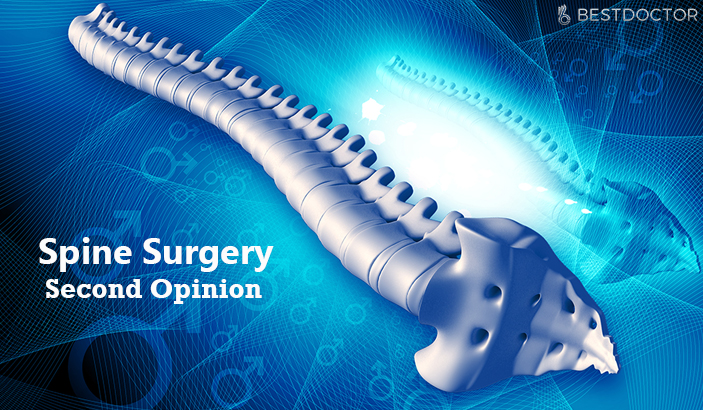The spine is one of the vital parts of the human skeletal system that consists of a series of vertebrae that extend from the base of the skull to the lower back and pelvis. It not only provides structure and support to the torso and abdomen but also encloses the spinal cord. So, it is not difficult to understand that spine surgery is a major operation that is potentially painful and involves slow recovery and a wrong diagnosis can lead to irreversible damage. Getting a second opinion before a spine surgery helps you to decide whether you really need the surgery recommended by your surgeon or there are other non-invasive or minimally invasive ways to resolve the problem.
A spine surgery second opinion from top Orthopedic doctors is like a second set of eyes that gives a better idea about your issue and the available treatment options at your disposal. But, still, now, most patients are scared to ask for a second opinion from their spine surgeon because they feel that it may appear disrespectful or insulting. But in reality, asking for a second opinion isn’t offending your surgeon; it is the duty of a responsible patient who is interested to take an active part in his/her treatment.
4 Reasons to Get Spine Surgery Second Opinion
Know Your Options
One of the main reasons to opt for a spine surgery second opinion is that in spine surgery there are different procedures and different approaches to treating a specific condition. While your first surgeon may recommend a traditional open back surgery, the second surgeon who gives you the second opinion may suggest a minimally invasive approach which involves a small incision or he may suggest a newer treatment option that does not require surgery at all. You need to know your options before choosing the one that is most suitable for your condition.
If The First Surgery Was Not Successful
If you have already had a back surgery which did not work out as expected and your bone doctor has recommended another surgery which is under process then it is a good idea to get a second opinion before getting on with the second surgery. In many cases, the initial fusion surgery does not work and further surgery will not be effective. In specific circumstances such as pseudarthrosis, a second surgery is likely to be helpful.
Make Sure You Have The Correct Diagnosis
Another important reason to seek a second opinion before undergoing spine surgery is to make sure that you have received the correct diagnosis. Despite the use of best imaging techniques and tests, certain spinal conditions are difficult to diagnose. When you opt for a second opinion, your X-rays, MRIs, and CT scans will be reviewed with fresh eyes. The surgeon may recommend an untried non-surgical treatment or even suggest an alternative diagnosis.
If You Have Confusions About Your Surgeon
You should be totally confident about your surgeon who is going to perform your spine surgery. If you have confusion with the diagnosis or if you are uncomfortable with the treatment then you deserve a second opinion before proceeding with the treatment. Seek a second opinion from a surgeon who will take time to answer all your questions and clarify all doubts. He should explain why a particular surgery is recommended, what are its benefits, as well as the potential risks involved in the procedure.
6 Types Of Spine Surgeries That Require The Second Opinion
Spinal Fusion
Spinal Fusion is the most common type of surgery for back pain. In this procedure, the doctor joins the spinal bones or vertebrae together to limit the motion between them and the length to which the nerves can stretch. Spinal Fusion does not limit your activity, but in rare cases, the bones fail to fuse completely. In such a case, the patient may need another operation to fix the condition.
Laminectomy
In this procedure, parts of the bones, bone spurs or ligaments are removed from the back. This surgery helps to relieve the pressure on the spinal nerves which helps to ease the pain and weakness of the back. But, this surgery can make your spine less stable. If such a situation arises, then the patient may need spinal fusion. In certain cases, the surgeons do Laminectomy and spinal fusion together.
Foraminotomy
In this procedure, the surgeon removes the bone at the sides of your vertebrae in order to widen the space where the nerves leave the spine. The extra space that is created helps to relieve pressure on the nerves and ease the pain. But this procedure can also make the spine less stable. So, the surgeon may need to do a spinal fusion with it.
Diskectomy
At times the disk (a cushion-like substance) present between the two vertebrae can move out of place and create pressure on a spinal nerve which can lead to back pain. In this procedure, the surgeon removes parts of the disk or the entire disk. This procedure can be done using a big cut or a small incision.
Disk Replacement
In this surgery, the surgeon replaces the damaged spinal disc with an artificial one and places it between the vertebrae. Just like fusion, this surgery also allows the patient to move his spine but recovery time is usually shorter compared to spinal fusion. But there are chances that the new disk can also slip or get displaced in which case it will need repair.
Interlaminar Implant
In this procedure, the surgeon implants a U-shaped device between two vertebrae in the lower back. This device opens the space between the vertebrae and relieves the pressure on the spinal nerves. Unlike spinal fusion, this device provides stability to the spine and allows almost normal range of motion.
The biggest risk involved in back surgery is the factor of unsure – not knowing for sure whether the surgery is going to ease your pain or not. Therefore, the best thing to do is ask an orthopedician to get the second opinion, who will be able to explain what is involved in the procedure and what are the expected results.
[cl-review quote=”Medically Reviewed By” author=”Dr. Kaushal M. Bhavsar (MBBS, MD)” occupation=”Assistant Professor in Pulmonary Medicine, GMERS Medical College, Ahmedabad” avatar_image=”1325″ source=”url:https%3A%2F%2Fwww.linkedin.com%2Fin%2Fdr-kaushal-bhavsar-a8137355%2F|target:_blank”]








Enhancing Your Career Opportunities with Improved Vision from LASIK Surgery in Manhattan
What Does Cloudy Urine Mean in Females and Males?
Palmar Hyperhidrosis: Understanding Causes, Symptoms, and Treatment
16 Warning Signs You Need to Go See Your Doctor As Early As Possible